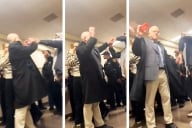You have /5 articles left.
Sign up for a free account or log in.
A gunman killed five students in a Northern Illinois University lecture hall before shooting himself Thursday afternoon. Many more were wounded: Aside from the perpetrator, Northern Illinois reported 21 victims in all.
The tragedy reemphasizes the intense focus on emergency response and communications systems that emerged after the April shootings at Virginia Tech University, experts said Thursday. But, President John Peters said in a press event, "I don't know if any plan can prevent this kind of tragedy."
Officials said Thursday that shortly after 3 p.m. the shooter, dressed in black, emerged from behind a screen in the front of the classroom, and opened fire. Northern Illinois identified the shooter as a former graduate student in sociology who was enrolled in the university in spring 2007 but no longer is. (The Chicago Tribune said it had identified the shooter, but wasn't naming him pending formal identification of his body, and that he was enrolled in a graduate program in social work at the University of Illinois at Urbana-Champaign, and that he had won a dean's award at Northern Illinois two years ago for work he did on prison systems.) He carried one shotgun and two handguns. Four of those killed were female; one was a male. Among those wounded was the instructor of the geology class, a graduate teaching assistant who related his account of the shootings to the Chicago Sun-Times.
Eric Rood, a Northern Illinois senior and copy desk chief at Northern Star, the student newspaper, said students in the newsroom and elsewhere were "glued to the TV" Thursday watching coverage of the shooting.
"There's definitely a lot of shock," he said. "No one's quite sure what to make of this."
Hours earlier, Rood was in another building on campus, waiting outside a classroom when a student who was in the room where the shooting occurred ran by him and several other students. Alarmed by the commotion, they took out their cell phones and soon found out what had happened, Rood said.
Along with dozens of other students, Rood took temporary shelter in an empty lecture hall. "People were confused," he said. "Mostly they just wanted to get out to see if their friends were OK."
The shooting comes less than a week after a student at Louisiana Technical College’s Baton Rouge campus shot and killed two other female students and then killed herself. About 20 students were in the classroom at the time. The investigation into the double murder and suicide is ongoing, and Baton Rouge Police say they haven’t uncovered a motive and have found no connections between the suspect and victims that would help understand why they were targeted.
Thursday's events at Northern Illinois also come at a time when Virginia Tech officials are considering how to honor students who died in last April's massacre there.
Amie Steele, editor of the Collegiate Times, Virginia Tech's student newspaper, said watching coverage of another college shooting was "peculiar" and "like deja vu all over again." Students throughout the student center, where the newsroom is located, were "staring in disbelief," she added.
"I think this will be a trigger for students," Steele said. "It's spring semester. We're already treading on thin ice, because students are starting to think about April, and it's been a topic on how to approach the one-year anniversary.... Seeing snow on the ground will trigger an emotional response from some students" (reminding them of the wintry day of the Virginia Tech shooting.)
Steele said she contacted a student she knows who worked at the Northern Illinois newspaper to provide words of wisdom about how to respond to and cover a tragedy. Likewise, Charles W. Steger, president of Virginia Tech, wrote a message to Peters, offering empathy and help. Steger also addressed a note to his own campus reminding students and employees of a 24-hour counseling hotline.
"[The president] is trying to quell any queasiness that people might have," said Larry Hincker, a Virginia Tech spokesman. "I know this will bring back memories of the trauma here."
As they did after April's shootings, several campus security and risk management experts weighed in Thursday on the national implications.
“Institutions face challenges in terms of reducing their vulnerability to random acts of violence. Things like perimeter security and weapons checks at doors are just not feasible and it’s not the kind of environment that campuses want to create,” said Ann H. Franke, who, as a lawyer and president of Wise Results, advises colleges on risk management. “The focus on emergency notification systems has been robust since the April Virginia Tech shootings. There are ongoing questions about the use of these types of systems -- for what kinds of emergencies, who sends out the messages. I think it’s very important for institutions to continue to focus on those kinds of issues.”
Daniel Carter, senior vice president for the nonprofit organization, Security On Campus, added Thursday evening that from all of the information then available, it appeared that Northern Illinois’s emergency warning and response system had worked. Northern Illinois's president had said that the Web site, e-mail, voicemail, crisis hotline, media, and alarm systems were all used to notify students. The first campus warning, he said, went out within 20 minutes (at 3:20 p.m.). Police reported that they responded to the scene within two minutes.
“This reinforces -- in part basically through its success from what we’ve seen -- the importance of having a multidisciplinary emergency response in place and having a multi-channel warning system in place," Carter said. (By "multidisciplinary" he meant having many different components and entities involved.) He noted, in particular, that Northern Illinois used a public address system -- something Security On Campus recommends be part of the communications strategy but which many colleges don’t have because of the investment in infrastructure needed -- but added that Northern Illinois’s response would have been even stronger had text messaging also been a component of its notification system.
“The story at the moment just demonstrates that a university is an open community and that irrational acts by individuals can occur at any time,” said Sheldon E. Steinbach, a lawyer in the higher education practice at the Washington firm Dow Lohnes. “People often make it look like schools are oblivious to the security of their broader community and that’s just not true. It is impossible without turning the campus into a police state to secure it any further than it already is.”
Authorities said Thursday that they did not know of any connection between Thursday's shootings and a security scare toward the end of the fall semester. In December, Northern Illinois shut down for a day after threatening graffiti, which referenced Virginia Tech, appeared in a residence hall.
In a December 11 letter to students and colleagues, President Peters shared some reflections on the incident. “Like so many of our students at NIU, I was a first-generation college student. The awe I felt the first time I stepped on a university campus has never left me. I see that same awe in the faces of every new student I meet, and I bask in the reflected pride of every graduate who walks across the stage at commencement. The great tradition of American public higher education is preparation of citizens who will live in and perpetuate a free, open and diverse society, and to be part of that important tradition is a source of unending pride. Events of the past several days cause me much distress because they are so contrary to the standards and commitments of this institution and of American higher education.”








